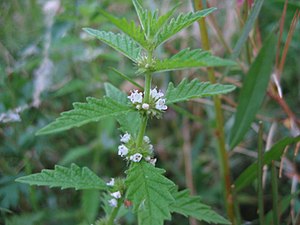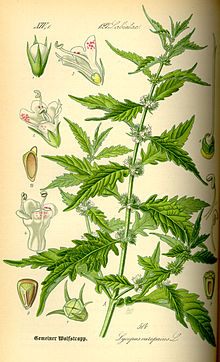Ufer-Wolfstrapp
| Ufer-Wolfstrapp | ||||||||||||
|---|---|---|---|---|---|---|---|---|---|---|---|---|

Ufer-Wolfstrapp ( Lycopus europaeus ) |
||||||||||||
| Systematics | ||||||||||||
|
||||||||||||
| Scientific name | ||||||||||||
| Lycopus europaeus | ||||||||||||
| L. |
The Shore Wolfstrapp ( Lycopus europaeus ), also Common Wolfstrapp called, is a plant from the family of the mint (Lamiaceae).
description
The Ufer-Wolfstrapp is a perennial herbaceous plant that reaches heights of 20 to 120 centimeters and can form long underground runners . It has roughly sawn leaves , of which only the lower ones can be pinnate.
The almost radial symmetry , four-fold bloom of the Ufer-Wolfstrapp has white-colored petals , which are provided with small purple dots. It has two fertile stamens , and sometimes two very short, regressed and sterile ones can also be present. The calyx teeth are longer than the calyx tube, about 2 mm long and always hairy. The ovary is four-part to the bottom. The Ufer-Wolfstrapp forms clipped Klausen fruits .
The number of chromosomes is 2n = 22.
ecology
The Ufer-Wolfstrapp is a hemikryptophyte (stem plant) or a marsh plant . Vegetative propagation as root creepers occurs through underground runners up to 20 centimeters in length.
It has different leaves ( heterophylly ), that is, the leaves are different depending on where they are on the stem: the upper ones are lanceolate to ovate; towards the bottom the leaves are indented and deeply pinnately fissured under water. The rhizome in the water is covered with finely divided water leaves, in the soil often with divided lower leaves .
The flower ecology is about "real lip flowers" in multi-flowered, axillary pseudo whorls ( cymes ), these are united to thyrsen as a whole inflorescence. The corolla is white with purple-colored speckled sap marks , about 3 millimeters long, weakly dorsiventral , funnel-like and blocked inside by coarse transverse hairs ("sap cover"). Only two anthers have developed which, like the style, protrude slightly from the flower. The flowers are also vormännlich and dreihäusig. The female flowers are much smaller than the male. Nectar is separated from the discus. Visitors are: wasps , flies , especially hover flies . Spontaneous self-pollination is possible with hermaphrodite flowers by bending the stamens after they have matured.
The four Klausen fruits are wedge-shaped and initially still connected at the bottom and thus form a cup-shaped expansion unit that - when dropped onto the water - retains an air bubble in the cavity and is therefore buoyant ( swimming spread ). The foursome ( split fruit ) breaks easily, and the small, spherical adhesive glands on the domed inside of the Klausen fruit stand out clearly. It is sticky to waterfowl, probably also animal litter .
Occurrence
The Ufer-Wolfstrapp occurs all over Europe up to China. There are also deposits in the Azores. In the temperate areas of eastern North America, it is a neophyte.
It grows quite often in reed beds or in sedge stocks, on banks and ditches, also in alder quarries. It occurs on different, but mostly occasionally flooded, nutrient-rich and base-rich, neutral-mild, musty-humic, sandy or pure clay or peat soils. According to Ellenberg, it is a semi-light plant, intermediate-continental distribution, a wet pointer, a weak acid to weak base pointer, preferring nitrogen-rich locations and a class character of the reed and large sedge swamps (Phragmitetea australis). But it also occurs in societies of the Alnetalia order.
Systematics
Lycopus europaeus was first published by Carl von Linné .
Two subspecies can be distinguished in the Ufer-Wolfstrapp ( Lycopus europaeus ):
- Common shore wolfstrapp ( Lycopus europaeus subsp. Europaeus )
- Soft Shore Wolfstrapp ( Lycopus europaeus subsp. Mollis (A. Kern.) Murr )
Ingredients and Medical Uses
The above-ground parts of the plant harvested shortly before flowering serve as medicinal plants. The finished preparations made from it are used for mild hyperthyroidism and its side effects such as nervousness and palpitations ; also with mastodynia (pain and tightness in the mammary gland). The effect on mild hyperthyroidism was also confirmed in a study.
Responsible for the pharmacological effect presumably among others present in the plant are phenolic acids , specifically the hydroxy cinnamic acid - derivatives . They have an antigonadotropic and antithyreotropic effect, which has been proven experimentally. The prolactin level in the blood is lowered.
Treatment should not be suddenly interrupted, however, and it is contraindicated in the presence of underactive thyroid and non-functional thyroid enlargement .
literature
- Ingrid and Peter Schönfelder : The new handbook of medicinal plants. Franckh-Kosmos Verlagsgesellschaft, 2004, ISBN 3-440-09387-5 .
Individual evidence
- ↑ a b Erich Oberdorfer : Plant-sociological excursion flora for Germany and neighboring areas . With the collaboration of Angelika Schwabe and Theo Müller. 8th, heavily revised and expanded edition. Eugen Ulmer, Stuttgart (Hohenheim) 2001, ISBN 3-8001-3131-5 , pp. 815-816 .
- ↑ a b c Rafaël Govaerts (Ed.): Lycopus europaeus. In: World Checklist of Selected Plant Families (WCSP) - The Board of Trustees of the Royal Botanic Gardens, Kew . Retrieved January 8, 2018.
- ↑ AM Beer, KR Wiebelitz, H. Schmidt-Gayk: Lycopus europaeus (Gypsywort): effects on the thyroidal parameters and symptoms associated with thyroid function. In: Phytomedicine . 15, 2008, pp. 16-22. PMID 18083505
Web links
- Ufer-Wolfstrapp. In: FloraWeb.de.
- Ufer-Wolfstrapp . In: BiolFlor, the database of biological-ecological characteristics of the flora of Germany.
- Lycopus europaeus L. s. st. In: Info Flora , the national data and information center for Swiss flora . Retrieved February 26, 2016.
- Lycopus europaeus subsp. mollis (A. Kern.) Murr In: Info Flora , the national data and information center for Swiss flora . Retrieved February 26, 2016.
- Distribution in the northern hemisphere
- Thomas Meyer: Wolfstrapp data sheet with identification key and photos at Flora-de: Flora von Deutschland (old name of the website: Flowers in Swabia )
- Pictures on BioPix.dk
- Ufer-Wolfstrapp on awl.ch

